
In January of 2020 Chicago’s rideshare tax on companies such as Uber and Lyft officially went into effect. After Mayor Lightfoot announced the highest tax in the nation on such companies, many believed Uber and Lyft would largely focus on other metropolitan areas for the time being. With an added $3 fee for trips that start or end in downtown, riders in the Loop are now finding themselves with much more expensive trips. All of this, of course, was to provide incentive for riders to take public transportation and to curb downtown traffic; however, many see this merely as an attempt for the City to make more money, which it has already stated will generate roughly $40 million annually, $2 million of which the Chicago Transit Authority will receive to improve bus lanes throughout the city.
While it is evident that Chicago needed to make adjustments to curb downtown traffic, it appears that this drastic increase in taxes could very well have the opposite effect on traffic. For instance, at the time of the announcement of the rideshare tax, Curbed Chicago stated “Uber pushed hard against them, arguing the tax is solely a revenue play and won’t alleviate congestion . . . it’s in favor of comprehensive congestion pricing that would tax delivery vehicles, trucks, and taxi cabs in addition to ride-hailing services.” This type of plan would follow closely with what New York City passed in 2018, in charging a tax for Manhattan rideshare vehicles and cabs putting both transit options on equal footing. The issue here is that while traffic has largely gotten far worse due to the adoption of rideshare services, the future of taxi use in cities is looking more and more bleak. This is obvious, though. The more our society adopts advancing technology and understands how to streamline well-established businesses, the likelier it becomes that older business models become obsolete. This is the issue that many see with Chicago’s new tax. In addition to passing the tax, Lightfoot lowered the license renewal fee for taxi drivers, clearly showing who she believed is to blame for the congestion issues. She’s not wrong either; however, we are now beginning to see that residents of Chicago may very well value paying extra for their own ride own, rather than cramming into a packed train each day.
This is no way serves as an endorsement for Uber or Lyft or ridesharing altogether. In fact, we have written many times regarding the issue that companies such as these bring when it comes to who is liable in an accident. Further, Lightfoot and the city of Chicago are right to provide options that attempt to decrease traffic and get more people using public transportation. Not only would this provide safer roads for all parties, but it would allow many to entirely ignore the dangers and issues that arise from severe traffic congestion altogether. Instead, we must acknowledge that while Lightfoot’s tax is progressive and surely appeared well-intentioned, rideshare companies are massive corporations that are not only well-connected, but well-funded and such measures by the City will only be met with attempted “solutions” by the companies that such a tax greatly effects.
“Driver Centers” May be the First Sign of More to Come from Rideshare Companies
In late February, Lyft officially opened its Chicago Driver Center, which marked the 6th location in the United States. The Driver Center, a hub for drivers to visit to receive discounted auto maintenance as well as be assisted with any Lyft-related questions regarding the business, is located at 1020 N. Elston Ave. According to Block Club Chicago, the new Driver Center is 22,500 sq. ft. and has roughly 30 employees at the location. The new center speaks volumes to the hold that rideshare companies now hold within not only the economy, but our everyday culture. Like it or not, Uber and Lyft are capable of ensuring that no matter what types of legislation is brought against them, they have the money and power to continue expanding their resources.
Unfortunately, while cities must enact legislation to curb issues plaguing high density areas, we are likely going to see Lyft and Uber remain in the Loop for good. True, people are likely less willing to pay a $3 additional charge to take a Lyft from work downtown to their destination; however, Chicago presents the unique aspect of having weather that plays a significant factor. Those with the means to already take a Lyft or an Uber as their daily mode of transportation likely are going to continue doing so. What’s more, the tax is not going to curb the amount of rideshare drivers in the city. Sure, there may be fewer people looking to take a Lyft, but Chicago is a massive city with a very complex infrastructure. While we should be happy Lightfoot and the City decided to take progressive steps to curb an issue that will only get worse, it looks like Lyft and Uber are only going to work even harder to now expand and ensure a presence in Chicago.
Reader Interactions